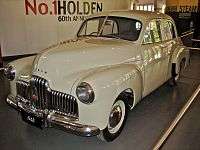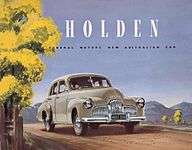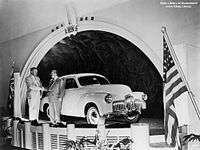Holden 48-215
| Holden 48-215 | |
|---|---|
 | |
| Overview | |
| Manufacturer | Holden (General Motors) |
| Also called | Holden FX (unofficial) |
| Production | 1948–1953 |
| Assembly |
Pagewood, New South Wales[1] Fortitude Valley, Queensland[1] Birkenhead, South Australia[1] Mosman Park, Western Australia[1] Woodville, South Australia[1] Fishermen's Bend, Victoria |
| Body and chassis | |
| Class | Mid-size |
| Body style |
4-door sedan (48-215) 2-door coupe utility (50-2106) |
| Layout | Front-engine, rear-wheel drive |
| Powertrain | |
| Engine | 132.5 cu in (2,171 cc) I6 |
| Transmission | 3-speed manual |
| Dimensions | |
| Wheelbase | 103 in (2,620 mm) |
| Length | 172 in (4,370 mm) |
| Width | 66.9 in (1,699 mm) |
| Height | 61.8 in (1,570 mm) |
| Curb weight | 2,230 lb (1,010 kg) |
| Chronology | |
| Successor | Holden FJ |
The Holden 48-215 is a mid-size, sedan that was produced by the Australian automaker Holden between November 1948 and October 1953. The 48-215 was the first model from General Motors in Australia to bear the Holden name.[2] In mainstream parlance, the official name of "Holden 48-215" was eschewed in favour of the shortened "Holden" designation. Following the replacement of the first Holden, the 48-215 gained the unofficial nickname of Holden FX. This arose as the replacement models were labeled FJ, FE, FC, et cetera, and it was therefore assumed by the general public that 48-215 must have been F-something as well, so the title FX came into use in used car advertisements, the "X" standing for the unknown.[3]
The design was originally penned in the United States by Chevrolet,[4] but was not used because it was deemed too small for the U.S. market as it developed after the war. Instead the design became the basis of only the 48-215 model. Its American origins are quite apparent, as it closely resembles Chevrolets of the period that did make it to production, particularly the Fleetline Aerosedan and the second generation Deluxe. Development of the 48-215 began in 1944.
Five prototypes
_sedan_(6102032141).jpg)
Three prototypes were built by hand in 1946 by American and Australian engineers at the General Motors workshop in Detroit. Months of durability and performance testing were undergone in the US before the three prototypes were shipped to Australia. Prototype number one was first registered (as a Chevrolet) in Victoria as JP-480 on 12 February 1947.[5] The only survivor of the prototypes, it is part of the National Museum of Australia collection.
A further two prototypes were built in Australia; all five prototypes were registered as Chevrolets. Only two were used for photographic purposes. They were:[5]
- Prototype No.1, JP-480, dark colour—Seine Blue (not Cadillac Blue)
- Prototype No.4, KY-442, light colour—Convoy Grey, owned by Australian businessman Peter Briggs between 1980-2013. The car's current value has been estimated to be worth over A$1 million when it was put up for auction in the Motorclassica auction Melbourne, in October 2013[6]
In the absence of an established supplier base in Australia for auto-making, new forging facilities had to be set up for producing crankshafts and a new foundry was set up for major castings.[7] In order to hasten the project to production some simplifications were incorporated.[7] There were no direction indicators, there was no provision for heating or demisting, and at the rear there was only a single, centrally positioned, tail lamp.[7] Because of the mild climate in most of the populated areas of the country, it was found possible to save weight and cost by using a relatively small 6-volt 11-plate battery.[7] Interior trim was minimised: weight reduction was pursued "with great vigour" and, in view of the 2,247 lb (1,019 kg) weight in "running trim", a success.[7]
Ten pilot cars
1948 timeline
- April, the production plant at Woodville, South Australia, begins tooling up to make the bodies—these would be identical to the prototypes. (Body number one, painted black, did not become pilot car number one). Also work begins on the engine assembly line at Fishermen's Bend.
- 1 September, the decision is made to call the car Holden.
- 25 September, engine number 1001 is started up.
- 30 September, pilot car number one is completed in the evening. (There was no celebration, as GMH did not designate this vehicle as No. 1 Holden—it came to be known as Old Number One).
- 19 October, pilot car number one is registered as MG-501.[5]
Production overview
All four Holden colours were represented:[5]
| Pilot car No. | Colour | Serial No. | Engine No. | Registration No. |
|---|---|---|---|---|
| 1 | Gawler Cream (Body No. six) | 8-1001-M | 1001 | MG-501 |
| 2 | Black | 8-1002-M | 1002 | MG-502 |
| 3 | Black | 8-1003-M | 1003 | MG-503 |
| 4 | Black | 8-1004-M | 1004 | MG-504 |
| 5 | Black | 8-1005-M | 1005 | MG-505 |
| 6 | Seine Blue | 8-1006-M | 1006 | MG-506 |
| 7 | Convoy Grey | 8-1007-M | 1007 | MG-507 |
| 8 | Black | 8-1008-M | 1008 | MG-508 |
| 9 | Black | 8-1009-M | 1009 | MG-509 |
| 10 | Black | 8-1010-M | 1010 | MG-510 |
These ten cars were used for testing. Three of them went to the Engineering Department, five went to Manufacturing, one went to the General Sales Manager, and one went to the managing director, H.E. Bettle.[5]
Volume production
When all departments were satisfied with the car, volume production began. The race was now on to ensure Holden dealers in all states had cars on their showroom floors before unveiling day. Black bodies dominated the early roll-out but GMH made sure that each capital city also received examples of cream, blue, and grey. Ultimately, 68 Holdens were distributed to the capital cities before unveiling day.[8]
On Sunday, 21 November, an Open Day was held to exhibit the entire factory (including the high-security design rooms) and the car itself. But this special preview was not for the public or the dealers—it was for the Fishermen's Bend employees and their families (GMH estimated that 12,000 guests attended). There were partly assembled cars at various stages along the assembly line as well as finished cars for the guests to inspect.[8]
The official launch for Victorian dealers was held at the Oriental Hotel in Melbourne on Friday, 26 November.[8]
Unveiling
The official unveiling by Prime Minister Ben Chifley commenced at 2:30 pm on Monday, 29 November 1948, in the Fishermen's Bend Social Hall. The 400 guests applauded when silver curtains parted to reveal a cream Holden, in a black velvet setting and sparkling under spotlights, as an orchestra played Brahms' Waltz in A-flat. The celebrations at the plant were attended by 1,200 official guests.[8] The Holden was released for sale to the public at Port Melbourne, Victoria. The car was marketed simply as the Holden, without a model name.[9] It had a 132.5 cu in (2,171 cc) cast-iron straight six engine which produced 60 hp (45 kW), connected to a three-speed manual transmission. It managed the 0–60 mph (0–97 km/h) sprint in 18.7 or 27.7 seconds.[4][10] Sources differ. It also had a dust proof body, and a small 37 ft turning circle.[10]
The 50-2106 coupe utility, based on the 48-215 sedan, was released in January 1951[11] and in July 1953 the "Holden Business" sedan, essentially a taxi version of the 48-215, was added to the range.[12] The 48-215 and 50-2106 models were replaced by the Holden FJ series in 1953.[13]
-

The first Holden 48-215 sedan off the production line.
-

Front cover of the sales brochure for the Holden 48-215. The car was marketed simply as the "Holden".
-

Holden 50-2106 Coupé Utility
-

Queensland launch of the vehicle, 1948
References
- 1 2 3 4 5 Ed's Eh Premier Build. Retrieved 23 August 2011
- ↑ Davis, Tony; Kennedy, Alistair; Kennedy, Ewan (February 2007). "The Holden Heritage - 13th Edition (Part One)". GM Holden. pp. 38–39. Archived from the original (PDF) on 15 September 2010.
- ↑ "HOLDEN - The Classic Models" by Ewan Kennedy with the Introduction by Peter Brock; From a paragraph on Page 1. First Published in 1997.
- 1 2 Willson, Quentin (1995). The Ultimate Classic Car Book. DK Publishing, Inc. ISBN 0-7894-0159-2.
- 1 2 3 4 5 Magazine "Restored Cars Australia" Number 106 Sept-Oct 1994, Page 14, article "THE 48-215 HOLDEN PART ONE"
- ↑ Cockington, James (23 October 2013). "Australia's first Holden offered for sale at $1m". The Sydney Morning Herald. Retrieved 6 December 2013.
- 1 2 3 4 5 "Holden Saloon (road test)". Autocar. 2 December 1948.
- 1 2 3 4 Magazine "Restored Cars Australia" Number 107 Nov-Dec 1994, Page 16, article "THE 48-215 HOLDEN PART TWO"
- ↑ Terry Bebbington & Michel A. Malk, 45 years of Holden, 1994, page 14
- 1 2 "Holden 48/215 FX Technical Specifications". Unique Cars & Parts. Retrieved 17 October 2011.
- ↑ The Holden Heritage, Eight Edition
- ↑ Aussie Cars (1987)
- ↑ Norm Darwin, 100 Years of GM in Australia, 2002, page 225
External links
- Holden 48-215 sales brochure Retrieved from Unique Cars and Parts on 15 September 2008
- Holden 48-215
- Holden Prototype Car No. 1 at the National Museum of Australia
| Holden, a marque of General Motors, automobile timeline, 1948–present |
|---|
| List of Holden vehicles † HQ–WB Statesmans not marketed under the "Holden" brand, but rather the separate "Statesman" brand. |